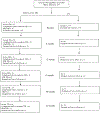From Early Childhood to Adolescence: Lessons About Traumatic Brain Injury From the Ohio Head Injury Outcomes Study
- PMID: 31996606
- PMCID: PMC7210058
- DOI: 10.1097/HTR.0000000000000555
From Early Childhood to Adolescence: Lessons About Traumatic Brain Injury From the Ohio Head Injury Outcomes Study
Abstract
Objective: The Ohio Head Injury Outcomes study was a 12-year longitudinal study of early childhood traumatic brain injury (TBI). This article reviewed the findings pertaining to caregiver and family functioning and child cognition, behavior, social competence, emotional functioning, and academics. We further considered individual and social-environmental influences on recovery and interventions.
Setting: Recruitment was completed at 3 children's hospitals and 1 general hospital.
Participants: Children aged 3 to 7 years at the time of injury with complicated mild to moderate and severe TBI or orthopedic injury requiring hospitalization were included.
Design: A concurrent cohort/prospective research design was used. A baseline assessment was completed shortly after the injury. Follow-up assessments were completed at 6, 12, and 18 months and at an average of 38 and 82 months postinjury.
Main measures: At baseline, parents/guardians completed retrospective ratings of their child's behavioral, emotional, and social functioning preinjury. At the subsequent assessments, ratings reflected current functioning. Information about current family and caregiver functioning was collected at each time point and cognitive testing was completed at selected time points.
Results and conclusions: Recovery after TBI is complex, varies over time, and involves injury-related and premorbid influences, cognition, genetics, and caregiver and family functioning. A sizable number of children with TBI have persisting unmet clinical needs.
References
-
- Anderson V, Godfrey C, Rosenfeld JV, Catroppa C. Predictors of cognitive function and recovery 10 years after traumatic brain injury in young children. Pediatrics. 2012; 129 (2): 254–261. - PubMed
-
- Anderson A, Catroppa C, Morse S, Haitou F, Rosenfeld J. Recovery of intellectual ability following traumatic brain injury in childhood: Impact of injury severity and age at injury. Pediatric Neurosurg. 2000; 32: 282–209. - PubMed
-
- Ewing-Cobbs L, Miner ME, Fletcher JM, Levin HS. Intellectual, motor, and language sequelae following closed head injury in infants and preschoolers. J Ped Psychol. 1989; 14(4): 531–547. - PubMed
-
- Ewing-Cobbs L, Fletcher JM, Levin HS, Francis DJ, Davidson K, Miner ME. Longitudinal neuropsychological outcome in infants and preschoolers with traumatic brain injury. J Int Neuropsychol Soc. 1997; 3(6): 581–591. - PubMed
Publication types
MeSH terms
Grants and funding
LinkOut - more resources
Full Text Sources
Medical


